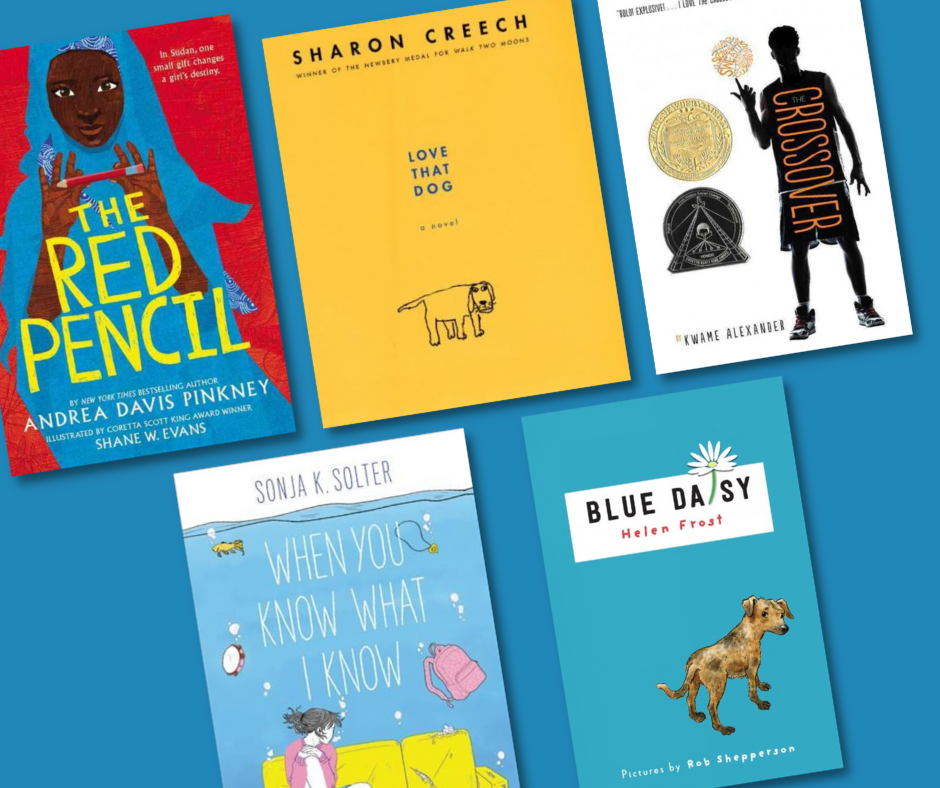Ah, Spring, that magical season when a young person's mind turns to thoughts of friendship, feelings, and free verse. No wonder April is Poetry Month!
Here in Philadelphia, the days are getting longer, the temperatures are getting warmer; buds, birds, and blooms begin to appear and creativity begins to stir in many minds. There are more than 16,000 entries in the Free Library’s catalog under Poetry, so where you pick your point to ponder the poets is entirely your preference. But have you ever considered the novel, that prose palace? Yes, the novel: home to chapters, characters, and developing storylines can also be a garden plot for verses to flower in. Novels written in poetic verse are known as—you guessed it—Novels in Verse or, sometimes, Verse Stories.
Here are 5 recommendations introducing middle-grade readers to the format:
The Red Pencil written by Andrea Davis Pinkney; illustrated by Shane Evans
A tale of heartache and hope in the possible, even in tragic times. Telling 12-year old Sudanese-born Amira Bright’s story in first-person verse, the author creates engaging characters through the poetry of their observations and the poignancy of their circumstances. This tale of displacement in a complex, war-torn country is both accessible and fluent, striking just the right tone for middle-grade readers. Evans’ elemental drawings illuminate the spirit and yearnings of Amira, the earnest protagonist.
Love That Dog by Sharon Creech
Creech has created a poignant, funny picture of a child’s encounter with the power of poetry. Readers can experience the main character’s artistic journey, poetic growth, and confidence because all of the selections mentioned in the story are included at the end.
The Crossover by Kwame Alexander
While twins Josh and Jordan’s story is compelling enough, what makes this verse novel excel is the poetry itself. The language paces the novel. Basketball games are succinctly captured in quick, staccato rhythms; languid free verse makes waiting for Josh’s punishment seem endless. Almost every page is an example of this synergy between what’s written and what’s written about. This book will appeal to both fans of basketball and fans of poetry. Teachers will love using this book for teaching language usage and vocabulary since much of the chapters are structured as definitions of words in the context of Josh's story. This quick read is highly recommended and will deliver a real emotional punch before the final buzzer.
When You Know What I Know by Sonja K. Solter
10-year-old Tori suffers, endures, rages, and heals after her uncle molests her. The single act happens right before Tori opens the first-person, free-verse narration by telling readers that once you know what she knows, "you can't / not know. / In your face, / under your eyelids." At first, Mom doesn't believe Tori, compounding Uncle Andy's atrocity and giving Tori a terrifying "whooshing-wave- / of-fire-and-ice-cold" in her body. But her 8-year-old sister is (surprisingly, but believably and vitally) present for her, as is her best friend. Tori's arc is about healing, her free-verse story more a sketch than a fleshed-out deep dive, but it never skirts the big things: emotional suffocation, powerlessness, silence, anger, and recovery.
Blue Daisy written by Helen Frost; illustrated by Rob Shepperson
"A dog shows up one summer day" and friends Sam (in verse) and Katie (in prose) tell the story of how the stray pup changes their neighborhood and their lives. When the dog settles for a snooze in Sam's backyard, the two kids impulsively sweep a paintbrush of blue paint across her back, creating a blue daisy. Sam and Katie struggle with their identity as good kids after treating an animal as an object and try to win the pooch's trust back. The book is acute about Sam and Katie's uncomfortable realization that their behavior is what determines their identity. It's a slightly old-fashioned scenario, especially in the contentedly free-roaming town pup, but the emotions and ethical notes ring true, and kids will find much food for thought here. Shepperson's friendly monochromatic line and watercolor art is sweet and homey, a tonal match to the text. A neighbor's recipes are included, and an author's note discusses the poetry.
What’s a favorite poem of yours? Does it tell a whole story? Do you like your poems long or short? Let us know in the comments!
Have a question for Free Library staff? Please submit it to our Ask a Librarian page and receive a response within two business days.






